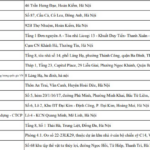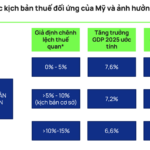1. Voluntary Social Insurance Contributions Entitle You to Maternity Benefits
Maternity allowance is one of the new regimes introduced by the 2024 Social Insurance Law, effective from July 1, 2025. According to the new Law, those who participate in voluntary insurance can enjoy the following regimes:

From July 1, 2025, the 2024 Social Insurance Law officially takes effect, granting maternity benefits to voluntary social insurance participants such as freelancers and homemakers. AI illustration by Hong Dao
Maternity Allowance
Retirement Pension
Survivor’s Pension
Before July 1, 2025: According to Point 2, Article 4 of the 2014 Social Insurance Law, participants in voluntary social insurance were only entitled to two regimes: retirement pension and survivor’s pension.
Evidently, from July 1, 2025 – the effective date of the 2024 Social Insurance Law, participants in voluntary social insurance, including freelancers and homemakers, are entitled to maternity benefits.
2. Househusbands Who Contribute to Voluntary Social Insurance Entitle Their Homemaking Wives to Maternity Allowance
As per the 2014 Social Insurance Law No. 58/2014/QH13, participants in voluntary social insurance were only entitled to two regimes: retirement and survivor’s pensions. Therefore, despite government subsidies, voluntary social insurance was not an attractive option for citizens.
To enhance the appeal of voluntary social insurance, the National Assembly passed the 2024 Social Insurance Law on July 29, 2024, which introduced maternity benefits to the policy for all participants.

Househusbands who contribute to voluntary social insurance entitle their homemaking wives to maternity allowance. AI illustration by Hong Dao
Accordingly, Article 94 of the 2024 Social Insurance Law No. 41/2024/QH15 stipulates that househusbands whose wives give birth are also entitled to maternity allowance.
Consequently, it is not mandatory for the wife to participate in social insurance; as long as the husband contributes to voluntary social insurance, the wife will be eligible for maternity benefits.
The maternity allowance granted is VND 2 million/child according to Article 95 of the 2024 Social Insurance Law.
Per Article 94 of the 2024 Social Insurance Law, the eligibility criteria for receiving maternity allowance are as follows:
First, participants who have contributed to voluntary social insurance or a combination of mandatory and voluntary social insurance for at least 6 months within the 12 months preceding childbirth are entitled to maternity allowance if they meet one of the following conditions:
– Female laborers who give birth.
– Male laborers whose wives give birth.
If both husband and wife participate in social insurance: Only one of them is entitled to receive maternity allowance.
If both spouses meet the conditions to receive maternity allowance under both voluntary and mandatory social insurance: They will only receive maternity benefits under mandatory social insurance.
Second, if the participating wife passes away after childbirth: The father/guardian is entitled to maternity allowance.
Third, if the wife meets the conditions for maternity benefits under mandatory social insurance, and the husband meets the conditions for maternity allowance under voluntary social insurance: The wife shall receive maternity benefits under mandatory social insurance, and the husband shall receive maternity allowance under voluntary social insurance.
And fourth, if the husband meets the conditions for maternity benefits under mandatory social insurance, and the wife meets the conditions for maternity allowance under voluntary social insurance: The husband shall receive maternity benefits under mandatory social insurance, and the wife shall receive maternity allowance under voluntary social insurance.
3. Househusbands Are Entitled to 60 Days of Paternity Leave from the Date of Their Wife’s Childbirth
Prior to July 1, 2025, according to Point d, Point 2, Article 34 of the 2014 Social Insurance Law, the duration of leave for enjoying the maternity regime stipulated in this clause was calculated within the first 30 days from the date of the wife’s childbirth.
However, from July 1, 2025, the days of leave for enjoying the maternity regime must fall within 60 days from the date of the wife’s childbirth. Accordingly, within 60 days from the wife’s childbirth, male laborers participating in mandatory social insurance are entitled to paternity leave with the following duration:

Househusbands are entitled to 60 days of paternity leave from the date of their wife’s childbirth. AI illustration by Hong Dao
– 5 working days for vaginal delivery.
– 7 working days for cesarean delivery or preterm birth before 32 weeks of gestation.
– 10 working days for twins. The househusband will be granted an additional 3 days (i.e., 13 days in total) for each child from the third child onwards in the case of triplets or more.
– 14 working days for twins delivered by cesarean section. In the case of triplets or more delivered by cesarean section, an additional 3 days will be granted for each child from the third child onwards.
If the laborer takes multiple leaves, the starting date of the last leave must fall within the first 60 days from the date of the wife’s childbirth, and the total duration of leave for enjoying the maternity regime must not exceed the stipulated duration.
Thus, from July 1, 2025, the law permits househusbands to take paternity leave for 60 days from the date of their wife’s childbirth instead of just the first 30 days as before July 1, 2025, but the total leave duration must not exceed the duration specified in Point 2, Article 53 of the 2024 Social Insurance Law.
Note: The husband can take more time off than the above-mentioned duration, but it will not be considered as paternity leave. He can request annual leave or unpaid leave for this purpose.
4. All Cases of Abortion Are Eligible for Maternity Benefits
Based on Article 52 of the new Social Insurance Law, the duration of leave for miscarriage, abortion, or stillbirth is stipulated as follows:
– Maximum 10 days: Pregnancy under 5 weeks.
– Maximum 20 days: Pregnancy from 5 weeks to under 13 weeks.
– Maximum 40 days: Pregnancy from 13 weeks to under 22 weeks.
– 120 days for pregnancy of 22 weeks or more.
Thus, when a laborer undergoes medical interventions to terminate the development of the fetus (simply understood as abortion), they will be eligible for maternity benefits, whether it is a pathological or unwanted abortion.
Before July 1, 2025, the social insurance agency only granted the regime to laborers who experienced miscarriage, abortion, stillbirth, or pathological abortion.
5. Mothers Are Still Entitled to 6 Months of Maternity Leave Even If the Baby Is Stillborn
According to Point 2, Article 52 of the 2024 Social Insurance Law
“In cases where female laborers with a gestational age of at least 22 weeks meet the conditions specified in Point 2 or Point 3 or Point 5, Article 50 of this Law, but experience miscarriage, abortion, intrauterine fetal death, or fetal death during labor, the female laborers and their spouses shall be entitled to leave and maternity benefits as in the case of childbirth.”
Thus, female laborers with a gestational age of at least 22 weeks who meet the conditions for maternity benefits but experience miscarriage, abortion, intrauterine fetal death, or fetal death during labor shall be entitled to maternity leave and benefits, along with their spouses.
This means that the mother is still entitled to 6 months of maternity leave, and the father is entitled to paternity leave, and both spouses will receive maternity benefits as usual.

Mothers are still entitled to 6 months of maternity leave even if the baby is stillborn. AI illustration by Hong Dao
Before July 1, 2025, according to Point 3, Article 34 of the 2014 Social Insurance Law, “In case the child is under 2 months old and dies after childbirth, the mother shall be entitled to 4 months of leave from the date of childbirth; if the child is 2 months old or older and dies, the mother shall be entitled to 2 months of leave from the date of the child’s death, but the duration of leave for enjoying the maternity regime shall not exceed 6 months.”
Additionally, according to the new Law, Point 4, Article 53 stipulates, “In cases where a female laborer with multiple pregnancies gives birth, but there is a stillbirth in the uterus or fetal death during labor, the duration of leave for enjoying the maternity regime and the one-time allowance at childbirth shall be calculated based on the number of fetuses, including both living and dead fetuses.”
6. One-Time Allowance at Childbirth Is Calculated Based on the Reference Level
Point 4, Article 58 of the 2024 Social Insurance Law regarding the one-time allowance at childbirth, receiving a child through surrogacy, or adopting a child under 6 months old stipulates that the one-time allowance for each child specified in Points 1, 2, and 3 of this Article shall be twice the reference level in the month when the female laborer gives birth, receives a child through surrogacy, or adopts a child.
Article 60 on convalescence and recovery of health after childbirth states that the allowance for one day of convalescence and recovery of health after childbirth shall be 30% of the reference level.
According to Point 13, Article 141 of the Social Insurance Law, when the base salary level has not been abolished, the reference level stipulated in this Law shall be equal to the base salary level.
At the time of abolishing the base salary level, the reference level shall not be lower than that base salary level.
Currently, the applicable base salary level is VND 2.34 million/month according to Decree 73/2024/ND-CP.
Before July 1, 2025, the one-time allowance and the convalescence allowance after childbirth were calculated based on the base salary level.
What are the Scenarios that Disqualify Individuals from Withdrawing Social Insurance Benefits in One Go, Effective July 1st?
The new Social Insurance Law of 2024 will come into force on July 1st, 2025, with significant revisions and additions to its provisions. One of the key highlights of this updated legislation is the introduction of a new one-time social insurance regime, marking a pivotal change in social security benefits for citizens.
Microsoft Vietnam Named in Social Insurance Delinquency List for 3 Billion VND
Microsoft Vietnam Limited Liability Company has been operating since 2007 as a subsidiary of Microsoft Corporation (USA), a global technology leader.
Mandatory Business Registration for Social Insurance: A Maximum of Nearly VND 12 Million per Month.
As of July 1st, business household owners will be mandated to participate in social insurance with a minimum contribution of 585,000 VND per month and a maximum of nearly 12 million VND. This significant change in policy ensures that these entrepreneurs are provided with essential social security benefits, fostering a more inclusive and supportive business environment in our country.
“Social Security Recovers $4.6 Billion; Workers Reap the Benefits”
With a stringent approach to technology and inspections, Vietnam Social Security has successfully recovered nearly VND 1,100 billion in overdue payments. This significant achievement is a testament to their unwavering commitment to protecting the rightful interests of tens of thousands of hardworking employees across the nation.













































